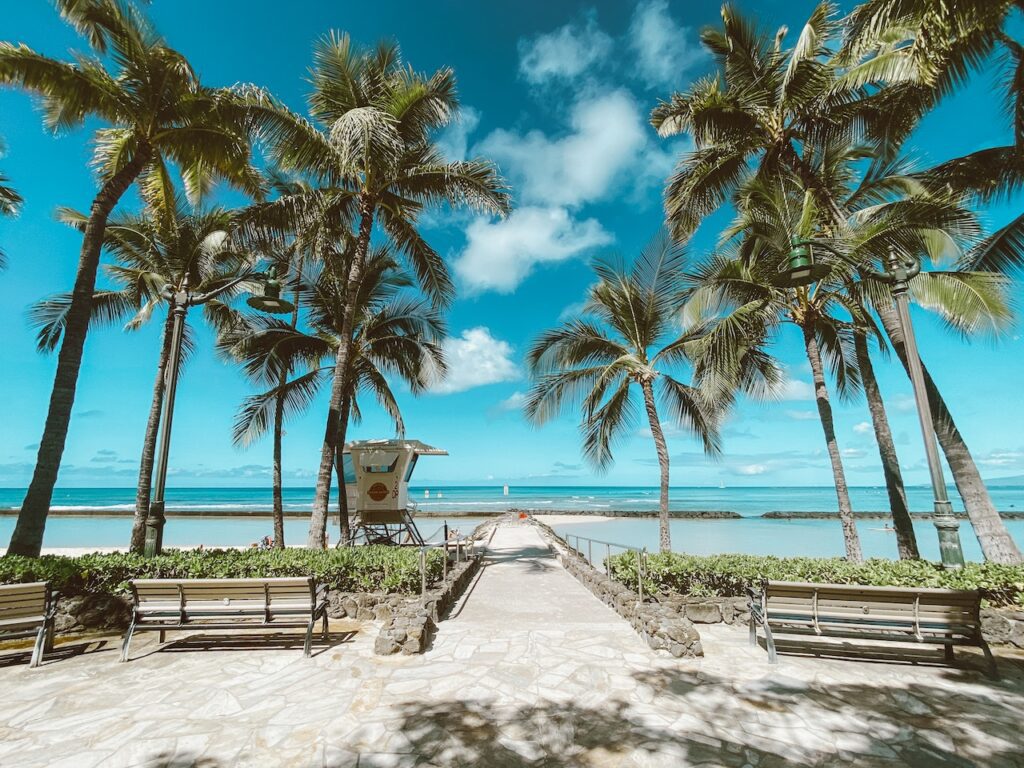Planning a trip to Hawaii? It’s essential to stay informed about the current travel restrictions and guidelines in place due to the ongoing COVID-19 pandemic. Understanding the requirements and regulations will help ensure a smooth and safe travel experience. Let’s take a closer look at the current Hawaii travel restrictions, COVID-19 guidelines, and travel requirements you need to know.
Key Takeaways:
- Hawaii has no COVID-19 related entry requirements for domestic travelers.
- International travelers must comply with U.S. federal requirements.
- No vaccination or negative COVID-19 test required for U.S. travelers to Hawaii.
- Some international travelers may still need COVID-19 vaccinations.
- The Safe Travels Hawaii program has been discontinued.
TRAVEL RESTRICITIONS HAVE BEEN DISCONTINUED
This article contains information related to the previous restrictions for historical purpose. There are no longer restrictions.
What You Need to Know Before Traveling to Hawaii

Before planning a trip to Hawaii, it is important to be aware of the current quarantine regulations and entry restrictions in place. This information will help ensure a smooth and hassle-free travel experience. Here are the key details you need to know:
Quarantine Regulations
Domestic travelers do not have to quarantine upon arrival in Hawaii. However, international travelers should be prepared to undergo a 5-day quarantine unless they have participated in the Safe Travels Pre-testing Program. It is essential to check the latest guidelines and requirements before traveling to ensure compliance and avoid any unexpected quarantine measures.
Entry Restrictions
While domestic travelers from the U.S. do not need proof of vaccination or a negative COVID-19 test before visiting Hawaii, it is advisable to closely monitor your health for COVID-19 symptoms. International travelers may still be required to provide proof of vaccination. It is crucial to stay updated on the specific entry restrictions and requirements for your destination in Hawaii to avoid any travel disruptions or complications.
By staying informed about the quarantine regulations and entry restrictions, you can better prepare for your trip to Hawaii and ensure a safe and enjoyable travel experience. Remember to check for any updates or changes in the guidelines before your departure to stay informed and compliant.
| Domestic Travelers | International Travelers |
|---|---|
| No quarantine required | 5-day quarantine unless participating in the Safe Travels Pre-testing Program |
| No proof of vaccination or negative COVID-19 test required | Possible requirement to provide proof of vaccination |
Hawaii Travel Updates and Guidelines
Staying informed about the latest travel updates and guidelines is crucial for anyone planning a trip to Hawaii. With the discontinuation of the Safe Travels Hawai‘i program, visitors are advised to stay updated on the travel advisories and guidelines issued by the state.
It is recommended to check the COVID-19 Community Level of your destination before traveling to Hawaii. This will help you understand the current situation and any associated risks. Additionally, it is advisable to pack at-home test kits, which can be used while traveling to ensure your safety and the safety of others.
Masks should be worn in indoor settings, on public transportation, and in crowded areas, in accordance with state guidelines. It is important to maintain physical distancing and practice good hand hygiene to reduce the risk of COVID-19 transmission. By following these guidelines and staying updated on the latest travel updates, you can have a safe and enjoyable trip to Hawaii.
COVID-19 Travel Rules
| Guidelines | Requirements |
|---|---|
| Testing | COVID-19 testing should be done no more than 3 days before travel. |
| Vaccination | COVID-19 vaccines are recommended for individuals aged six months and older. Booster shots are available for those aged 5 and older. |
| Masks | Masks should be worn in indoor settings, on public transportation, and in crowded areas. |
| Physical Distancing | Maintain at least 6 feet of distance from non-household members. |
| Hand Hygiene | Regularly wash and sanitize hands to reduce the risk of infection. |
Maui Travel Updates
Traveling to Maui? Stay up-to-date with the latest travel updates and information specific to the island. While West Maui has reopened, please note that Lahaina remains closed to the public due to ongoing cleanup efforts from recent wildfires. It is important for visitors to be aware of these closures and plan their itinerary accordingly.
Maui offers a variety of attractions and activities for travelers to enjoy. From beautiful beaches to stunning hiking trails and cultural experiences, there is something for everyone. However, it is essential to stay informed about any changes or restrictions that may impact your travel plans.
To ensure a smooth and enjoyable trip to Maui, we recommend checking for updates on the official Maui County website or contacting the local tourism office. They will provide the most accurate and up-to-date information regarding travel guidelines, reopening dates, and any closures or restrictions in place.
Maui Travel Updates: Current Status
| Destination | Status |
|---|---|
| West Maui | Reopened |
| Lahaina | Closed due to ongoing cleanup efforts from wildfires |
It’s always a good idea to have a backup plan in case of unexpected closures or changes. Consider exploring other areas of Maui or engaging in activities that are currently open and accessible. The local tourism office can provide recommendations for alternative attractions and experiences.
By staying informed and flexible, you can make the most of your trip to Maui and enjoy all that this beautiful island has to offer. Remember to follow all safety guidelines and protocols, including wearing masks indoors and practicing good hygiene. Safe travels!
Hawaii COVID-19 Testing and Vaccination Requirements
To ensure the safety of travelers and residents, Hawaii has implemented specific testing and vaccination requirements related to COVID-19. These guidelines apply to both domestic and international travelers entering the state. It is important to familiarize yourself with these requirements before planning your trip to Hawaii.
Testing Requirements
Before traveling to Hawaii, all visitors must undergo a COVID-19 test no more than 3 days prior to their departure. The test must be a NAAT or PCR test, and the negative result must be uploaded to the Safe Travels Hawaii program website. Failure to provide a negative test result may result in mandatory quarantine upon arrival.
It is also important to note that even if you have been fully vaccinated against COVID-19, a negative test result is still required for entry into Hawaii. Vaccinated individuals are not exempt from the testing requirement.
Vaccination Requirements
While COVID-19 vaccination is highly recommended for all travelers aged six months and older, it is not currently a mandatory requirement for entry into Hawaii. However, international travelers may still be required to provide proof of vaccination, so it is advisable to check the specific requirements of your home country and the destination.
Additionally, booster shots are now available for individuals aged 5 and older. It is recommended to stay updated on the latest vaccination guidelines and recommendations as they may change over time.
| Testing Requirements | Vaccination Requirements |
|---|---|
| Undergo a COVID-19 test no more than 3 days prior to departure | COVID-19 vaccination is highly recommended |
| Test must be a NAAT or PCR test | Proof of vaccination may be required for international travelers |
| Negative test result must be uploaded to the Safe Travels Hawaii program website | Booster shots now available for individuals aged 5 and older |
It is crucial to stay updated on any changes to the testing and vaccination requirements before traveling to Hawaii. Compliance with these guidelines will help ensure the safety and well-being of all visitors and residents alike.
International Travel Guidelines
For travelers planning to visit Hawaii from outside the United States, it is important to be aware of international travel guidelines and restrictions. Before embarking on your journey, it is advisable to visit the CDC Travel website and the U.S. Department of State website for specific information and updates on travel requirements.
When traveling internationally, it is crucial to check country-specific health information and alerts on the CDC’s Travelers’ Health website. Each country may have its own set of entry requirements, including COVID-19 testing, vaccination, and quarantine protocols. It is essential to stay informed and comply with these guidelines to ensure a smooth and safe travel experience.
Key Considerations for International Travel
- Research and abide by the entry requirements of your destination country.
- Check if COVID-19 testing or vaccination proof is required before departure or upon arrival.
- Be prepared for possible quarantine protocols at your destination.
- Ensure you have access to medical services and insurance coverage while abroad.
- Stay updated on any travel advisories or alerts issued by your home country and the destination country.
International travel during the COVID-19 pandemic comes with inherent risks, and it is important to evaluate these risks before making any travel plans. Consider the current situation, the prevalence of COVID-19, and the availability of healthcare facilities at your destination. It is always advisable to prioritize your health and safety when making travel decisions.
Preparing for Travel and Return
When planning a trip to Hawaii, it is important to make necessary preparations and be aware of the quarantine guidelines in place. Travelers should consider the potential for travel changes, additional lodging expenses, and the possibility of COVID-19 infection during their trip.
Upon returning home, it is recommended for travelers to test for COVID-19 five days after their arrival. This helps to ensure the safety of oneself and others in the community. Hawaii residents who leave the state and return should also be aware of the government-mandated quarantine or pre-travel testing requirements in place.
By staying informed about the latest travel restrictions and guidelines, individuals can have a smoother and more enjoyable travel experience. It is always advised to check for any updates or changes to the guidelines before embarking on a trip to Hawaii. This will help to ensure compliance with the necessary requirements and ensure a safe and hassle-free journey.
Quarantine Guidelines in Hawaii
In Hawaii, quarantine guidelines vary depending on the traveler’s origin and vaccination status. Domestic travelers, including those from the United States, do not have to quarantine upon arrival. However, international travelers should be prepared to undergo a 5-day quarantine unless they have participated in the Safe Travels Pre-testing Program.
Residents of Hawaii who leave the state and return should also be prepared for potential quarantine or testing requirements. It is important to stay updated on the latest guidelines and requirements issued by the state to ensure compliance and a smooth return home.
| Traveler Type | Quarantine Requirement |
|---|---|
| Domestic Travelers (US) | No quarantine required |
| International Travelers | 5-day quarantine, unless participated in the Safe Travels Pre-testing Program |
| Hawaii Residents returning from travel | Potential quarantine or testing requirements |
It is essential to adhere to the quarantine guidelines to ensure the safety and well-being of oneself and the local community in Hawaii. By following these guidelines and making necessary preparations, travelers can have a stress-free and enjoyable trip to the beautiful islands of Hawaii.
General Travel Guidelines during COVID-19
Traveling during the COVID-19 pandemic requires careful consideration and adherence to general travel guidelines to minimize the risk of infection and ensure a safe journey. These guidelines aim to protect both travelers and the communities they visit. Here are some key recommendations to keep in mind:
1. Follow Local Guidelines
Before embarking on your trip, research and familiarize yourself with the current travel restrictions, guidelines, and requirements in your destination. Stay updated on any changes in local regulations and be prepared to comply with mask mandates, social distancing measures, and other safety protocols enforced in the area.
2. Practice Good Hygiene
One of the most effective ways to prevent the spread of COVID-19 is through proper hygiene practices. Wash your hands regularly with soap and water for at least 20 seconds, or use hand sanitizer with at least 60% alcohol content when soap is not available. Avoid touching your face, especially your eyes, nose, and mouth, and cover your mouth and nose with a tissue or your elbow when coughing or sneezing.
3. Wear a Mask
Wearing a mask is an essential preventive measure, especially in public settings where maintaining physical distance may be challenging. Make sure to wear a well-fitting mask that covers both your nose and mouth. Follow local guidelines regarding mask usage, and wear a mask on public transportation, in crowded areas, and indoors where required.
4. Maintain Physical Distancing
To reduce the risk of transmission, it is important to keep a safe distance from others who are not part of your household. Stay at least 6 feet (about 2 meters) away from people whenever possible, both indoors and outdoors. Avoid crowded places and choose activities and attractions that allow for adequate physical distancing.
5. Stay Home if Unwell
If you experience any symptoms of COVID-19, such as fever, cough, or shortness of breath, it is crucial to stay home and postpone your travel plans. Prioritize your health and the well-being of others by seeking medical advice, getting tested if necessary, and following the recommendations of healthcare professionals.
By following these general travel guidelines, you can help protect yourself and others while enjoying a safe and responsible journey during the ongoing COVID-19 pandemic.
Safe Travel Practices
When traveling during the ongoing COVID-19 pandemic, it is important to prioritize safety and follow recommended practices to protect yourself and others. By implementing these covid-19 safety measures, you can help minimize the spread of the virus and ensure a safe travel experience.
Wearing Masks
One of the key safe travel practices is wearing masks. Masks should be worn indoors, especially in crowded areas, and on public transportation. They serve as a barrier to prevent respiratory droplets from spreading, reducing the risk of transmission. Make sure to wear a mask that covers your nose and mouth properly and follow local guidelines regarding mask usage.
Maintaining Physical Distance
Another important practice is maintaining physical distance from individuals outside of your household. Keep a distance of at least six feet whenever possible, especially in crowded places. Avoid close contact with people who are sick and follow any physical distancing guidelines provided by local authorities.
Hand Hygiene
Regular hand hygiene is crucial in preventing the spread of COVID-19. Wash your hands frequently with soap and water for at least 20 seconds. If soap and water are not available, use hand sanitizer with at least 60% alcohol content. Avoid touching your face, especially your eyes, nose, and mouth, as these are entry points for the virus.
Staying Home if Experiencing Symptoms
If you are experiencing symptoms of COVID-19, such as fever, cough, or shortness of breath, it is essential to stay home and avoid traveling. Traveling while sick can increase the risk of spreading the virus to others. Follow local guidelines for testing and seek medical advice if needed.
Post-pandemic Data and Research
The COVID-19 pandemic has had a significant impact on travel and tourism worldwide, including in Hawaii. As the situation continues to evolve, data and research are essential for understanding the effects of the pandemic and planning for the future. Here, we explore some key insights and post-pandemic data related to Hawaii’s travel industry.
Throughout the pandemic, the Hawai‘i Safe Travels digital platform has collected valuable data on visitor trends and COVID-19 testing results. This data will be retained for three years after the end of the program, providing researchers with a wealth of information to analyze. While personal details will be removed to ensure privacy, the anonymized data could offer valuable insights into traveler behavior, the effectiveness of safety measures, and the overall impact of the pandemic on Hawaii’s tourism sector.
Researchers may use this data to identify patterns, trends, and potential areas for improvement in future travel guidelines and protocols. It could also help inform decision-making processes to better manage and mitigate the impacts of any future crises. By analyzing this post-pandemic data, policymakers, industry stakeholders, and researchers can work together to develop strategies that promote safe and sustainable tourism in Hawaii.
Key Takeaways:
- The Hawai‘i Safe Travels digital platform will retain data for three years after the end of the program.
- Anonymized data from the platform could offer valuable insights into traveler behavior and the overall impact of the pandemic on Hawaii’s tourism sector.
- Research using this data may help identify patterns, trends, and potential areas for improvement in future travel guidelines.
- Post-pandemic data analysis can inform decision-making processes to better manage and mitigate the impacts of any future crises.
| Insights | Implications |
|---|---|
| Analyzed visitor trends | Inform targeted marketing strategies and resource allocation |
| Effectiveness of safety measures | Improve future protocols and guidelines |
| Impact on tourism sector | Guide recovery plans and sustainable tourism initiatives |
Conclusion
Staying informed about the current Hawaii travel restrictions and guidelines is crucial for travelers. The State of Hawai‘i has ended its Safe Travels Hawai‘i program and visitors should check their island’s COVID-19 Community Level and follow state, tribal, local, and territorial restrictions. Domestic travelers do not need proof of vaccination or a negative COVID-19 test before coming to Hawai‘i, but international travelers must comply with U.S. federal requirements. Testing for COVID-19 should be done no more than 3 days before travel and masks should be worn in indoor settings and crowded areas.
It is advisable to closely monitor health for COVID-19 symptoms and practice safe travel practices, such as wearing masks, maintaining physical distance, and practicing good hand hygiene. Travelers should be prepared for potential travel changes, additional expenses, and testing 5 days after returning home. Older adults and individuals with serious chronic medical conditions should postpone nonessential travel, and anyone experiencing COVID-19 symptoms should avoid travel.
Overall, by following the recommended safety measures, travelers can help ensure a safe and healthy travel experience during the ongoing COVID-19 pandemic. Testing, vaccination, and adhering to guidelines are key takeaways for those planning a trip to Hawaii. Stay informed, stay safe, and enjoy your trip to the beautiful islands of Hawaii!
FAQ
What are the current Hawaii travel restrictions?
There are no COVID-19 related entry requirements for domestic travelers. International travelers must comply with U.S. federal requirements and may be subject to a 5-day quarantine unless participating in the Safe Travels Pre-testing Program. Hawaii residents leaving and returning to the state should also be aware of quarantine or testing requirements.
What do I need to know before traveling to Hawaii?
Domestic travelers do not have to quarantine upon arrival in Hawaii. Proof of vaccination or a negative COVID-19 test is not required for U.S. travelers. International travelers should be prepared for a 5-day quarantine unless participating in the Safe Travels Pre-testing Program. It is recommended to closely monitor health for COVID-19 symptoms.
What are the Hawaii travel updates and guidelines?
The State of Hawaii has ended its Safe Travels Hawaii program. Visitors should check their island’s COVID-19 Community Level and follow state, tribal, local, and territorial restrictions. West Maui has been reopened, but Lahaina remains closed to the public due to ongoing cleanup efforts from wildfires. Stay updated on the latest travel advisories and guidelines issued by the state.
What are the Maui travel updates?
West Maui has been reopened, but Lahaina remains closed to the public due to ongoing cleanup efforts from wildfires. Stay informed about the latest updates specific to Maui.
What are the COVID-19 testing and vaccination requirements for Hawaii?
Testing for COVID-19 should be done no more than 3 days before travel. COVID-19 vaccines are recommended and available for individuals aged six months and older. Booster shots are also available for those aged 5 and older. International travelers may still be required to provide proof of vaccination.
What are the international travel guidelines?
International travelers should visit the CDC Travel website and the U.S. Department of State website for specific information about international travel. Check country-specific health information and alerts on the CDC’s Travelers’ Health website. Evaluate the risks associated with international travel and consider access to medical services.
How should I prepare for travel and return?
Be prepared for potential travel changes and additional lodging expenses in case of COVID-19 infection during the trip. Test for COVID-19 5 days after returning home. Hawaii residents leaving and returning to the state should be aware of government-mandated quarantine or pre-travel testing requirements.
What general travel considerations should I keep in mind?
Older adults and individuals with serious chronic medical conditions should consider postponing nonessential travel. If experiencing COVID-19 symptoms, travel should be avoided. Follow guidance from the CDC and U.S. State Department Travel website for determining whether to postpone or proceed with travel within the US and for information on travel restrictions.
What are the safe travel practices I should follow?
It is recommended to wear masks indoors, on public transportation, and in crowded areas. Maintain physical distance from non-household members and practice regular hand hygiene. Stay home if experiencing symptoms. Following these practices can help prevent the spread of COVID-19.
What will happen to the data stored in the Hawaii Safe Travels digital platform?
The data will be retained for three years after the end of the program. A version of the information, with personal information removed, may be made available for research purposes in the future to analyze visitor trends during the pandemic.

Scott Sweeney is the creator of Virtual Hawaii 360. Scott is a professional marketer and a lifelong Hawaii enthusiast. Scott splits time between Oahu and Dayton, Ohio. In addition to his marketing endevours, he is also a published Ukulele musician.





